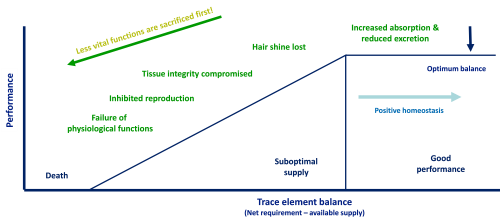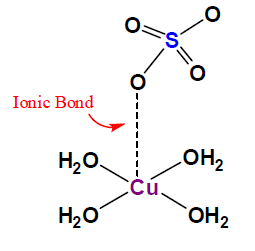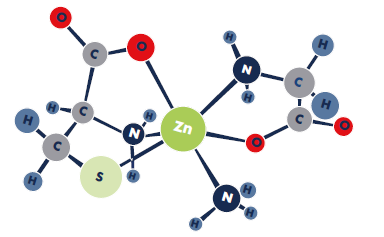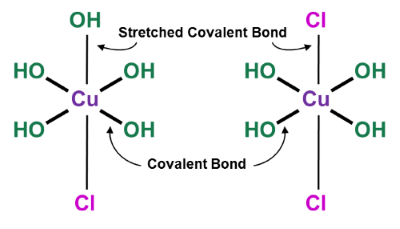Trace Mineral Forms and Their Importance
Introduction
Trace minerals are an important part of Poultryfeeds as they play crucial roles in its growth and production. Though required in smaller quantity, they carry out essential vital functions within the bird’s body. Their presence in optimal quantities is necessary for achieving growth and production efficiency in the flock. The deficiency of these trace minerals can be quite evident as that of major minerals, nonetheless, it will be reflected in terms of subclinical signs like non-uniformity, inconsistent performance etc., as shown in Fig. 1
Fig 1: Trace Mineral Deficiency and Animal Performance

Different forms of Trace Minerals
The requirement of trace minerals will depend on various factors like species, breed, age, production stage, feed intake, etc. Merely supplying a said quantum of trace mineral will not suffice the animal’s requirement. It is the form and the level of trace minerals and the antagonists present in the diet that will determine the availability of trace minerals to the animal for metabolic functions. There are two major forms/sources in which trace minerals are available: inorganic and organic. In addition to the differences in the efficiency of absorption of the target metal into the bloodstream, different sources can affect nutrition and animal performance in at least four other important ways: (1) destruction of nutrients, including vitamins, in a feed mixture, (2) interactions with other nutrients in the digestive tract, (3) direct influence on gut microbial ecology; and (4) effects on the animal’s natural immune functions. The common thread which links the mechanisms in all of these performance criteria is the speed with which the trace mineral is released in the feed or in the gut. There are many possible chemical and biochemical reactions that are constantly competing for the supplemented metal. The main thing that differentiates how different mineral forms perform is the strength of the bonds holding them in the source compound.
Oxides are the earliest forms of trace minerals that were used in the animal nutrition industry, followed by the sulphates and organic forms. The recent innovation in trace minerals, is the Hydroxy forms of trace minerals (Trouw brand: IntelliBond®) that improve the nutrient stability in feed along with optimizing animal production.
The various forms of trace minerals need to be diligently chosen by the animal producer with respect to their production goal.
Inorganic forms:
These include the oxide, sulphate, carbonate forms etc. They have weak ionic bond in their structure (Fig. 2), making them highly soluble and reactive in both feed and animal, limiting their absorption and related bioavailability. Their chemistry also leads to hygroscopicity of some forms of the trace minerals (Eg. Copper sulphate), making handling of these forms not that easy. They are comparatively inexpensive sources and easily available.
Fig. 2: Chemical structure of inorganic trace minerals

Organic Forms:
These include trace minerals bound with organic ligands (Trouw Brand: Optimin®) like amino acids, proteinates, MHA etc., by covalent bond (Fig. 3). This structure protects them from reactivity in feed and gut, thereby enhancing their bioavailability. The strength of the bond will further determine the solubility, stability and bioavailability of these organic forms, as not all the forms display similar level of bioavailability. Their perceived limitation is in terms of the variability in forms (amino acids, proteinates etc.), mixed solubility & stability, cost (comparatively expensive) and lesser mineral content.
Fig. 3: Chemical structure of organic trace minerals

Hydroxy trace minerals:
A new category of trace minerals, known as hydroxy trace minerals (Trouw brand: IntelliBond®), belong to the group of inorganic trace mineral sources, but have similar chemically stable structures as that of organically bound trace minerals. Covalent bonds and a unique crystalline matrix structure, as shown in Fig. 4, provide a reliable stability, which differentiates hydroxy trace minerals from both organic and inorganic minerals. In contrast to sulphate/oxide forms, these products exhibit extremely low solubility at neutral pH, which provides increased trace mineral stability in the intestine. Occurrence of less reactive trace element ions in the upper digestive tract is associated with fewer interactions with other feed components. The crystalline structure releases the trace elements slowly over the full length of the small intestine) resulting in a targeted release at the site of absorption and enhanced effects on intestinal health.
Fig. 4: Chemical structure of hydroxyl trace minerals

Their free flowing (non-hygroscopic) nature, higher mineral content, low solubility and lesser reactivity, makes these hydroxyl trace minerals the ideal choice of the trace minerals forms to be included in animal diets.
Conclusion
The role of trace minerals in improving animal health and performance is very well documented and understood. The form in which they are supplied is highly critical and makes a big difference with respect to the return on investment. Bioavailability is key in trace mineral nutrition and is dependent on the strength of the chemical bond of the trace mineral. With trace minerals, the logic of “the more, the better” does not work out, as it can lead to antagonist interactions, limiting their absorption. Hydroxy and organic forms of trace minerals turn out be sustainable forms as well, by reducing the environmental emissions. Therefore, judicious call needs to be taken with respect to supplementation of trace minerals in right quantity in right form for them to be bioavailable and economically viable to the producer.
Please get in touch with your local Trouw Nutrition representative for more information on Optimin® and IntelliBond® OR contact us at customercareindia@trouwnutrition.com